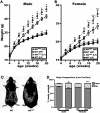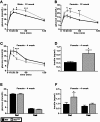Selective loss of leptin receptors in the ventromedial hypothalamic nucleus results in increased adiposity and a metabolic syndrome
- PMID: 18258679
- PMCID: PMC2329259
- DOI: 10.1210/en.2007-1200
Selective loss of leptin receptors in the ventromedial hypothalamic nucleus results in increased adiposity and a metabolic syndrome
Abstract
Leptin, an adipocyte-derived hormone, has emerged as a critical regulator of energy homeostasis. The leptin receptor (Lepr) is expressed in discrete regions of the brain; among the sites of highest expression are several mediobasal hypothalamic nuclei known to play a role in energy homeostasis, including the arcuate nucleus, the ventromedial hypothalamic nucleus (VMH), and the dorsomedial hypothalamic nucleus. Although most studies have focused on leptin's actions in the arcuate nucleus, the role of Lepr in these other sites has received less attention. To explore the role of leptin signaling in the VMH, we used bacterial artificial chromosome transgenesis to target Cre recombinase to VMH neurons expressing steroidogenic factor 1, thereby inactivating a conditional Lepr allele specifically in steroidogenic factor 1 neurons of the VMH. These knockout (KO) mice, designated Lepr KO(VMH), exhibited obesity, particularly when challenged with a high-fat diet. On a low-fat diet, Lepr KO(VMH) mice exhibited significantly increased adipose mass even when their weights were comparable to wild-type littermates. Furthermore, these mice exhibited a metabolic syndrome including hepatic steatosis, dyslipidemia, and hyperleptinemia. Lepr KO(VMH) mice were hyperinsulinemic from the age of weaning and eventually developed overt glucose intolerance. These data define nonredundant roles of the Lepr in VMH neurons in energy homeostasis and provide a model system for studying other actions of leptin in the VMH.
Figures





References
-
- Reilly MP, Rader DJ 2003 The metabolic syndrome: more than the sum of its parts? Circulation 108:1546–1551 - PubMed
-
- Zhang Y, Proenca R, Maffei M, Barone M, Leopold L, Friedman JM 1994 Positional cloning of the mouse obese gene and its human homologue. Nature 372:425–432 - PubMed
-
- Ahima RS, Osei SY 2004 Leptin signaling. Physiol Behav 81:223–241 - PubMed
-
- Matkovic V, Ilich JZ, Badenhop NE, Skugor M, Clairmont A, Klisovic D, Landoll JD 1997 Gain in body fat is inversely related to the nocturnal rise in serum leptin level in young females. J Clin Endocrinol Metab 82:1368–1372 - PubMed
-
- Saad MF, Damani S, Gingerich RL, Riad-Gabriel MG, Khan A, Boyadjian R, Jinagouda SD, el-Tawil K, Rude RK, Kamdar V 1997 Sexual dimorphism in plasma leptin concentration. J Clin Endocrinol Metab 82:579–584 - PubMed
Publication types
MeSH terms
Substances
Grants and funding
LinkOut - more resources
Full Text Sources
Other Literature Sources
Medical
Molecular Biology Databases
Research Materials
Miscellaneous

